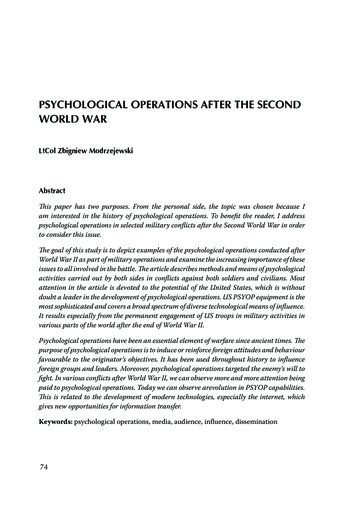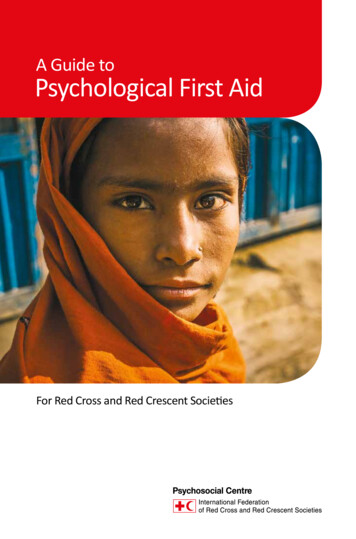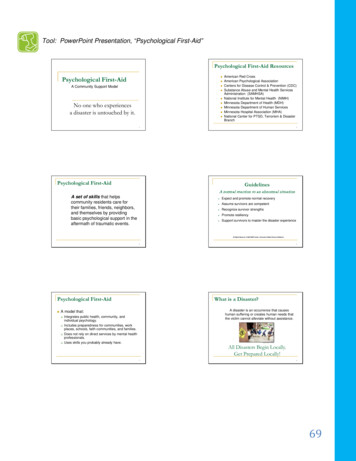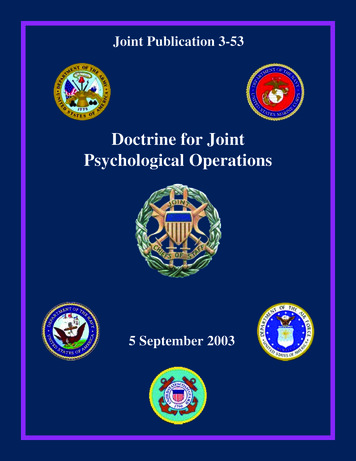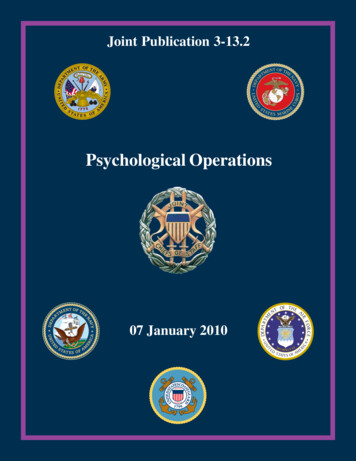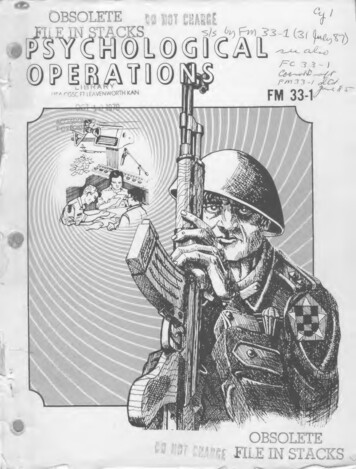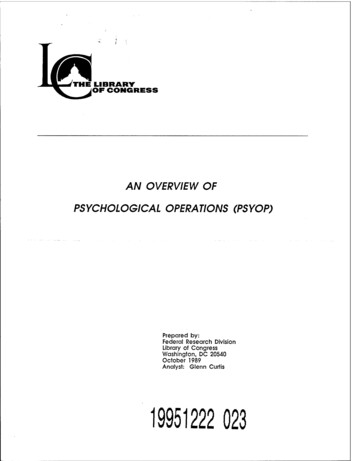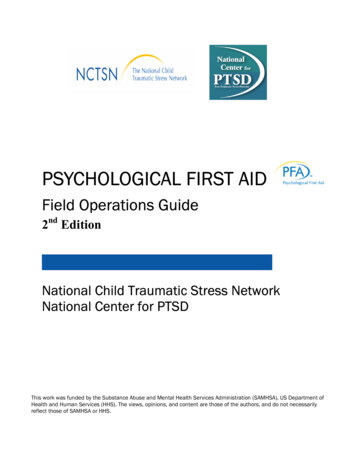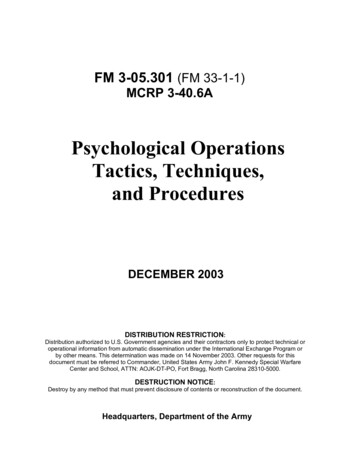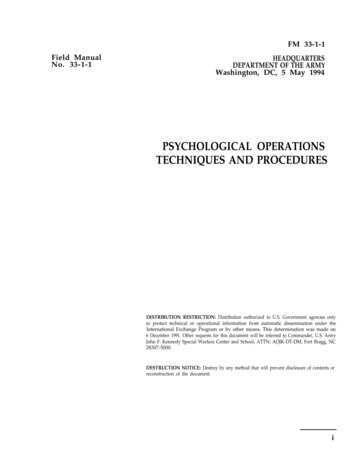
Transcription
FM 33-1-1Field ManualNo. 33-1-1HEADQUARTERSDEPARTMENT OF THE ARMYWashington, DC, 5 May 1994PSYCHOLOGICAL OPERATIONSTECHNIQUES AND PROCEDURESDISTRIBUTION RESTRICTION: Distribution authorized to U.S. Government agencies onlyto protect technical or operational information from automatic dissemination under theInternational Exchange Program or by other means. This determination was made on6 December 1991. Other requests for this document will be referred to Commander, U.S. ArmyJohn F. Kennedy Special Warfare Center and School, ATTN: AOJK-DT-DM, Fort Bragg, NC28307-5000.DESTRUCTION NOTICE: Destroy by any method that will prevent disclosure of contents orreconstruction of the document.i
FM 33-1-15 MAY 1994By Order of the Secretary of the Army:GORDON R. SULLIVANGeneral, United States ArmyChief of StaffOfficial:MILTON H. HAMILTONAdministrative Assistant to theSecretary of the Army06413DISTRIBUTION:Active Army, USAR, and ARNG: To be distributed in accordancewith DA Form 12-11E, requirements for FM 33-1-1, PsychologicalOperations, Techniques, and Procedures (Qty rqr block no. 5177) U.S. Government Printing Office: 1994 — 528-027/80126
FM 33-1-1ii
FM 33-1-1iii
FM 33-1-1iv
FM 33-1-1PrefaceThis field manual (FM) sets forth techniques and procedures for implementingUnited States (U.S.) Army psychological operations (PSYOP) doctrine containedin FM 33-1. It provides general guidance for commanders and planners who mustconsider the psychological impact of military operations on various targetaudiences. It also provides guidance for PSYOP personnel preparing operationalelements for commitment. It describes procedures for carrying out PSYOPprograms in support of other military operations. PSYOP commanders and trainersat all levels should use it with the Army Training and Evaluation Program (ARTEP)to plan and conduct their training.It integrates PSYOP into the Army’s battlefield operating systems (BOS) and isintended for ArmyWide dissemination. Its organization generally follows the sequenceof the product development process from planning through impact assessment.This manual is a guideline, not a regulation. As such, the techniques and proceduresit presents should not limit the user, as long as he follows Army doctrine, nationalpolicy, and the commander’s intent.In this manual, the word “opponent” applies to groups or individuals who areengaged in conflict-military, political, or otherwise-with the United States,whether or not war has been formally declared.The proponent for this publication is U.S. Army John F. Kennedy Special WarfareCenter and School (USAJFKSWCS). Submit changes for improving thispublication on Department of the Army (DA) Form 2028 and forward it toCommander, ATTN: AOJK-DT-DM, Fort Bragg, North Carolina 28307-5000.The provisions of this publication are the subject of the international agreements listedin the references.Many terms, acronyms, and abbreviations are found in the manual. Users shouldrefer to the glossary for their meanings or definitions.Unless this publication states otherwise, masculine nouns and pronouns do not referexclusively to men.v
FM 33-1-1Glossary-1
FM 33-1-1Glossary-2
FM 33-1-1Glossary-3
FM 33-1-1Glossary-4
FM 33-1-1Glossary-5
FM 33-1-1Part II. Definitionsaccessibility - The availability of an audience for targeting by psychologicaloperations.agents of action - Persons and organizations who carry out or conduct programs ofpsychological actions.*Discretionary - Persons or organizations whose activities are planned primarilyfor their psychological impact.* Incidental - Persons or organizations whose activities generate a psychologicalimpact secondary to the military operation.battlefield psychological activities - (DOD, NATO) Planned psychological activitiesconducted as an integral part of combat operations and designed to bringpsychological pressure to bear on enemy forces and civilians under enemy control inthe battle area, to assist in the achievement of the tactical objectives. (Joint Pub 1-02)capability - (DOD) The ability to execute a specified course of action. (Acapability may or may not be accompanied by an intention.) (Joint Pub 1-02)chemical warfare - (DOD) All aspects of military operations involving theemployment of lethal and incapacitating munitions/agents and the warning andprotective measures associated with such offensive operations. Since riot controlagents and herbicides are not considered to be chemical warfare agents, those twoitems will be referred to separately or under the broader term “chemical,” whichwill be used to include all types of chemical munitions/agents collectively. Theterm “chemical warfare weapons” may be used when it is desired to reflect bothlethal and incapacitating munitions/agents of either chemical or biological origin.(Joint Pub 1-02)civil affairs - (DOD) Those phases of the activities of a commander which embracethe relationship between the military forces and civil authorities and people in afriendly country or area or occupied country or area when military forces are present.Civil affairs include matters concerning the relationship between military forceslocatcd in a country or area and the civil authorities and people of that country or areausually involving performance by the military forces of certain functions or theexercise of certain authority normally the responsibility of the local government. Thisrelationship may occur prior to, during, or subsequent to military action in time ofhostilities or other emergency and is normally covered by a treaty or other agreement,expressed or implied. (Joint Pub 1-02)collateral special operations activities - The inherent capabilities of all militaryforces may periodically be applied to accomplish missions other than those forwhich the forces are principally organized, trained, and equipped. Collateralactivities in which special operations forces, by virtue of inherent capabilities,may be tasked to participate include humanitarian assistance, security assistance,search and rescue, counterdrugs, antiterrorism and other security activities, andspecial activities. (Joint Pub 3-05)Glossary-6
FM 33-1-1conditions - Those externalelements that affect a target audience but over which thereis little or no control. Conditions may be man-made or environmental in nature.consolidation - (DOD) The combining or merging of elements to perform acommon or related function. (Joint Pub 1-02)consolidation PSYOP - Psychological operations conducted in foreign areasinhabited by an enemy or potentially hostile populace and occupied by U.S. forcesor in which U.S. forces are based, to result ultimately in behaviors by the foreignpopulace that support U.S. objectives in the area.counterinsurgency - (DOD) Those military, paramilitary, political, economic,psychological, and civic actions taken by a government to defeat insurgency.(Joint Pub 1-02)counterpropaganda - Programs of products and actions designed to nullifypropaganda or mitigate its effects.counterterrorism - Offensive measures to prevent, deter, and respond toterrorism, including intelligence gathering and threat analysis in support of thosemeasures. (Joint Pub 3-05)country team - Senior members of U.S. Government agencies assigned to a U.S.diplomatic mission overseas and subject to the direction or supervision of theChief, U.S. Mission (ambassador). Normally, such members meet regularly(weekly) to coordinate U.S. Government political, economic, and militaryactivities and policies in the host country. (See also U.S. country team.)deception - Those measures designed to mislead the enemy by manipulation,distortion, or falsification of evidence to induce him to react in a mannerprejudicial to his interests. (Joint Pub 1-02)foreign internal defense - (DOD) Participation by civilian and military agencies of agovernment in any of the action programs taken by another government to free andprotect its society from subversion, lawlessness, and insurgency. (Joint Pub 1-02)foreign nation support - Civil resources identification, negotiation, andprocurement from available resources within a foreign nation in support of theU.S. military mission during wartime, preparation for war, or peacetime.host nation - A nation in which representatives or organizations of another stateare present because of government invitation or international agreement. The termparticularly refers to a nation receiving assistance relevant to its national security.insurgency - (DOD, NATO) An organized movement aimed at the overthrowof a constituted government through use of subversion and armed conflict.(Joint Pub 1-02)joint special operations area (JSOA) - A restricted area of land, sea, and airspaceassigned by a theater commander to the commander of joint special operationsforces to conduct special operations activities. The SOC or JSOTF commanderGlossary-7
FM 33-1-1assigns specific JSOAs (or sectors of a single JSOA) to a subordinate SOFcommander for mission execution. The scope and duration of the SOF mission,friendly and hostile situation, and politico-military considerations all influencethe number, composition, and sequencing of SOF elements deployed into a JSOA.It may be limited in size to accommodate a discrete direct action mission or may beextensive enough to allow a continuing broad range of unconventional warfareoperations. (Joint Pub 3-05)key communicator - An individual to whom the target audience turns most oftenfor an analysis or interpretation of information or events.media - Transmitted of information and psychological products.military operations short of war - The range of military actions required by theNational Command Authorities, except those associated with major combatoperations conducted pursuant to a declaration of war or authorized by the WarPowers Limitations Act, in support of national security interests and objectives.These military actions can be applied to complement any combination of the otherinstruments of national power and occur before and after war. (This information iscontained in Joint Pub 3-07 [Proposed Final Pub].)national objectives - (DOD) Those fundamental aims, goals, or purposes of anation-as opposed to the means for seeking these ends—toward which a policyis directed and efforts and resources of the nation are applied. (Joint Pub 1-02)opponent - An antagonistic force or organization that counters missionaccomplishment by military means.peacekeeping - Operations using military forces and/or civilian personnel at therequest of the parties to a dispute to help supervise a cease-fire agreement and/orseparate the parties.peacemaking - Diplomatic process of arranging an end to disputes and solvingtheir underlying causes.peace-building - Postconflict diplomatic and military action to identify andsupport structures which will tend to strengthen and solidify peace in order toavoid a relapse into conflict.peace-enforcement - Military intervention to forcefully restore peace betweenbelligerents who may be engaged in combat.product - Any visual, audio, or audiovisual item generated and disseminated insupport of a PSYOP program.product development center (PDC) - That organization within the operationselement of a PSYOP battalion or company in which programs of products oractions are developed.Glossary-8
FM 33-1-1propaganda * (DOD) Any form of communication in support of national objectives designedto influence the opinions, emotions, attitudes, or behavior of any group in order tobenefit the sponsor either directly or indirectly.* (NATO) Any information, ideas, doctrines, or special appeals disseminated toinfluence the opinion, emotions, attitudes, or behavior of any specified group inorder to benefit the sponsor either directly or indirectly.psychological actions - Activities conducted for their psychological impact.psychological operations * (DOD) Planned operations to convey selected information and indicators toforeign audiences to influence their erections, motives, objective reasoning, andultamately the behavior of foreign govenment, organizations, groups, andindividuals. The purpose of psychological operations is to induce or reinforceforeign attitudes and behavior favorable to the originator’s objectives. Alsocalled PSYOP.* (NATO) Planned psychological activities in peace and war directed to enemy,friendly, and neutral audiences in order to influence attitudes and behavioraffecting the achievement of political and military objectives. They includestrategic psychological activities, psychological consolidation activities, andbattlefield psychological activities.psychological warfare - The planned use of propaganda and other psychologicalactions having the primary purpose of influencing the opinions, emotions,attitudes, and behavior of hostile foreign groups in such a way as to support theachievement of national objectives. (Joint Pub 1-02)PSYOP campaign - A series of PSYOP programs conducted at the theater level toachieve short- and mid-term objectives in support of a CINC’s goals.PSYOP objective - A statement of a measurable response that reflects the desiredattitude or behavior change of a selected foreign target audience as a result ofpsychological operations.PSYOP program - A sequential, coordinated presentation of a series of actionsand/or products to achieve a specific PSYOP objective.* action program - A sequential, coordinated presentation of a series of actionsto achieve a specific PSYOP objective.* product program - A sequential, coordinated presentation of a series ofproducts to achieve a specific PSYOP objective.strategic psychological activities - (DOD, NATO) Planned psychologicalactivities in peace and war which normally pursue objectives to gain the supportand cooperation of friendly and neutral countries and to reduce the will and thecapacity of hostile or potentially hostile countries to wage war. (Joint Pub 1-02)Glossary-9
FM 33-1-1symbol - A visual or aural means used to convey a theme.target audience - An individual or group selected for influence or attack by meansof psychological operations.target audience analysis - The process by which potential target audiences areidentified and analyzed for effectiveness, accessibility, and susceptibility.theme - A theme is a subject, topic, or line of persuasion used to achieve apsychological objective.unconventional warfare - A broad spectrum of military and paramilitary operationsconducted in enemy-held, enemy-controlled, or politically sensitive territory.Unconventional warfare includes, but is not limited to, the interrelated fields ofguerrilla warfare, evasion and escape, subversion, sabotage, and other operations of alow visibility, covert, or clandestine nature. These interrelated aspects ofunconventional warfare may be prosecuted singly or collectively by predominantlyindigenous personnel, usually supported and directed in varying degrees by (an)external source(s) during all conditions of war or peace. (Joint Pub 142)U.S. country team - The senior, in-country, U.S. coordinating and supervisingbody, headed by the chief of the U.S. diplomatic mission, usually an ambassador,and composed of the senior member of each represented U.S. department oragency. (See also country team.)vulnerability - Manifestation of an unsatisfied or perceived need in an individualor a target audience.Glossary-10
FM 33-1-1CHAPTER 1OverviewThe PSYOP mission is derived from the supported unit’s mission. This manual describesbasic PSYOP techniques and procedures the commander and planners use to accomplishtheir missions. It shows how PSYOP personnel may use these techniques and proceduresto change the behavior of a target audience, to capitalize on other assets, to project power,and to assess the effect of PSYOP in support of the commander in chief’s (CINC’s) theatercampaign plan. The appendixes further describe recommended formats, technicalcapabilities, and techniques. (DO NOT CONFUSE THE PSYOP CAMPAIGN WITH THETHEATER CAMPAIGN PLAN, WHICH IT SUPPORTS.)PSYOP in the Operational ContinuumPSYOP function in peace, conflict, and war. They support special andconventional operations as a force multiplier. For example, duringbuilding-clearing in urban operations, PSYOP personnel use loudspeakers toconvince belligerents that their position is untenable and to encourage them tocease hostilities. This use of loudspeakers, combined with demonstrations offirepower, can reduce casualties. Loudspeaker operations were effective in urbanoperations in the 1989 Operation Just Cause in Panama.To be effective, PSYOP must be an integral part of their commander’s missionplanning process. PSYOP may be particularly effective in—Reducing the intensity and duration of armed combat.Making armed combat unnecessary.Taking advantage of an opponent’s psychological stress during combatoperations when armed conflict is used as a psychological weapon.Special Operations ImperativesAs a special operations (SO) element, PSYOP are planned and employed based onthe SO imperatives (Figure 1-1, page 1-2). These imperatives give focus to specialoperations forces (SOF) and SO doctrine in the operational continuum. They1-1
FM 33-1-1require that PSYOP personnel plan and execute military PSYOP in accordancewith (IAW) national policy guidelines. For a complete discussion of the SOimperatives, see FM 100-25.PSYOP Capabilities and LimitationsThe PSYOP unit’s ability to accomplish its mission is directly related to the scopeof the mission and the PSYOP assets available. PSYOP support to a commander isbased on a number of internal and external factors (Figure 1-2, page 1-3).PSYOP CycleThe PSYOP cycle aids in converting the mission into programs of support. (SeeFigure 1-3, page 1-4). The cycle consists of three phases: assessing, planning, andexecuting. During these phases, the PSYOP personnel apply the following processes:Intelligence gathering.Target audience analysis.Product development.Media selection.Media production.Dissemination.1-2
FM 33-1-1Monitoring is applied continuously during the cycle. During assessment, PSYOPpersonnel gather intelligence information. As part of this process, they consider theirown situation, environmental influences, target audience, and they collateinformation. During planning (target audience analysis, product development, andmedia selection), they analyze the mission, compare courses of action (COAs),develop recommendations (decisions), and tailor assets. Execution includes mediaproduction and dissemination. In applying these processes, PSYOP personnel pretestand posttest the product and modify it based on feedback.SummaryDeveloping and executing a PSYOP campaign in support of a theater campaignplan is a dynamic application of the PSYOP cycle to produce behavior changes intarget audiences that aids military operations and supports the commander’smission accomplishment. The chapters in this manual outline the processesthrough which PSYOP personnel develop PSYOP supporting plans, products, andactions. These supporting plans, products, and actions, combined with the actionsof other agencies, yield a PSYOP campaign in support of the theater campaignplan. This cycle must be continuous, evolutionary, and closely coordinated withthe supported forces combat operations.1-3
FM 33-1-11-4
FM 33-1-1CHAPTER 2Capabilities andLimitationsPSYOP may support operations of general purpose (GP) and SO forces, provide assets fornon-PSYOP dissemination missions, and provide the commander with a method ofinforming his opponent of his alternatives. The PSYOP unit’s ability to accomplish itsmission depends on the scope of the mission and the PSYOP assets available. A fullunderstanding of the commander’s mission and the type of support required is critical tothe success of the PSYOP support.Role and ResponsibilitiesPSYOP units operate as support units, not as stand-alone forces. Their primary roleis to support other military units or U.S. Government agencies in accomplishingU.S. national objectives. Their overall responsibilities are to—Assess the psychological impact of military operations.Advise the military commander or the Department of Defense (DOD) missiondirector on PSYOP campaigns.Develop and conduct PSYOP campaigns in support of military operations.Counter hostile propaganda.Other Uses of PSYOP AssetsPSYOP units may support other military units in a variety of ways. PSYOP assetsand expertise may support a commander’s other mission-oriented activities, suchas disaster relief. In domestic cases, the commander must ensure PSYOP assets arebeing employed in a dissemination role only and not to project a PSYOP message.PSYOP assets may also support a commander’s deception plan or the activities ofthe military or other government agencies. (See Appendix A.)PSYOP assets provide target audience information and regional and languageexpertise. They also disseminate information and products that explain the intent2-1
FM 33-1-1of military operations to target audiences. For example, a commander may usePSYOP assets to inform civilians that the purpose of an operation is to reducecivilian casualties and minimize their interference in the operation.Considerations in Using PSYOP AssetsCommanders must consider PSYOP capabilities and limitations when integratingPSYOP in other military operations (Figure 2-l). As in all military operations,time is a major consideration. To ensure effective PSYOP support, commandersmust give timely predeployment notification to PSYOP assets. The PSYOPcampaign begins before the main body of combat forces arrives in country. Inaddition, operations officers should integrate PSYOP liaisons directly into theirstaff to ensure continuous PSYOP input during the planning process.Accurate and complete information about the major factors that influence thetarget audience is often not part of the intelligence collection plan. Such lack ofinformation restricts the number of exploitable vulnerabilities. Restrictions onnews, public discussion, and travel limit the information available to evaluatePSYOP effectiveness.Effective PSYOP require imaginative personnel who know the target audience’slanguage. These personnel must also understand the political, economic, cultural,social, and ideological conditions of the target audience.2-2
FM 33-1-1Target audiences may be beyond the limits of PSYOP targeting methods due tophysical or policy limitations. In these cases, PSYOP planners must refer thesetargets to other agencies for targeting.Operational ContinuumPSYOP units function in peace, conflict, and war. PSYOP may be strategic,operational, tactical, or consolidation. Strategic, operational, and tactical PSYOPdepend on the size of the target audience, the geographical area in which theprograms are applied, and the time span in which observable results are required.Consolidation PSYOP are designed to return an area to normalcy in the aftermathof war or conflict.Strategic PSYOPStrategic PSYOP are generally designed to further broad or long-term aims insupport of general strategic planning, with measurable effects becoming visible inthe indefinite future. U.S. Army PSYOP forces can be task organized to supportstrategic PSYOP. Strategic PSYOP objectives and conditions among opponents(opportunities) that may contribute to reaching those objectives are shown inFigure 2-2, page 2-4.Operational PSYOPOperational PSYOP are regional or national in scope. They are directed at regionaltarget audiences and planned to change audience behavior more rapidly thanstrategic PSYOP. Operational PSYOP demonstrate characteristics of bothstrategic and tactical PSYOP and are the bridge that links them together.Operational PSYOP objectives and conditions among opponents (opportunities)that may contribute to reaching those objectives are shown in Figure 2-3, page 2-4.Tactical PSYOPTactical PSYOP are prepared and executed in objective areas in direct support ofmilitary tactical operations. Tactical PSYOP objectives and conditions amongopponents (opportunities) that may contribute to reaching those objectives areshown in Figure 2-4, page 2-5.Consolidation PSYOPConsolidation PSYOP are conducted in newly accessible or formerlyopponent-held territory. Emphasis is on a return to normalcy. The objectives ofconsolidation PSYOP and conditions among opponents (opportunities) that cancontribute to reaching those objectives are shown in Figure 2-5, page 2-5.2-3
FM 33-1-12-4
FM 33-1-1SummaryPSYOP derive their effectiveness from being an integral part of the operation fromstart to finish. They are not substitutes for combat power, but they may significantlyenhance the combat unit’s mission accomplishment. When skillfully and closelyintegrated with military and political actions, they act as a catalyst and can often makethe difference between success and failure in mission accomplishment.2-5
FM 33-1-1CHAPTER 3PSYOP Cycle andPlanning ProceduresAs with any operation, detailed PSYOP planning upon recelpt of mission is essential.PSYOP must be fully Integrated Into the operation plan (OPLAN) or operation order(OPORD). The PSYOP cycle relies on specific external and Internal planning procedures.PSYOP CyclePSYOP planning follows a deliberate cycle that examines external and internalplanning requirements. It is designed to carry the mission from conception throughexecution and follow-up assessment. The PSYOP cycle has three basicphases—assessing, planning, and executing. (See Figure 1-3, page 1-4.)AssessingDuring this phase, the PSYOP commander identifies and assesses several factors:his own situation, the environmental influences, and the target audience. Hegathers and collates the information relative to these factors and includes it in thePSYOP commander’s estimate.PlanningThe planning phase involves the complete analysis of the mission and thecomparison of COAs. Based on the recommendations by his staff, the PSYOPcommander selects the COAs and tailors his assets to ensure successful executionof the mission. The planning phase produces an OPLAN or OPORD.ExecutingDuring the executing phase, the PSYOP commander issues orders to supportingunits. The PSYOP products are pretested and posttested and the feedback isevaluated. The final assessment of these factors may lead to reassessing thesituation and further PSYOP planning.3-1
FM 33-1-1PSYOP ProcessesThe PSYOP cycle aids in converting the mission into programs of support. Duringthe cycle, the PSYOP personnel apply the following processes:Intelligence GatheringPSYOP personnel use intelligence products in a dual approach. The first approachis the analytical approach. During this approach, PSYOP personnel use extensivebackground data to assemble a “picture” of the target. The second approach is thetarget approach. In this approach, the PSYOP personnel search for a targetaudience that has the power to channel its behavior to produce the desired results.PSYOP personnel continuously use the dual approach when planning andimplementing PSYOP.Target Audience AnalysisAfter PSYOP planners analyze the target audiences, they classify them into twogroups— intermediate and ultimate. The group classification is determined by thetarget audience’s likely effectiveness in generating a desired behavior. Whenselecting a target audience, the PSYOP planner adheres to the purpose of groupclassification. The function of the intermediate audience is to send a message.Examples of intermediate audiences are foreign key communicator and media.The function of the ultimate audience is to act on a message.Product DevelopmentThe product development process is normally the responsibility of the productdevelopment center (PDC). The product development process involves —Coordinating the PSYOP mission.Analyzing the target audience.Determining the capability of PSYOP planners and regional experts toproduce draft models of PSYOP products and actions.Media SelectionDuring product development and agents of action selection, the PDC selects theappropriate media. This selection is based on the accessibility and susceptibility ofthe target audience. The PDC finishes and disseminates the products and actionsconsistent with program production and dissemination capabilities, agentabilities, and campaign design.Media ProductionAfter the objective, target audience, theme, and media have been selected, thePDC begins developing a package or prototype for the production facility. PSYOPunits pretest these prototype products to determine their effectiveness.DisseminationPSYOP personnel determine the best means to disseminate PSYOP products toselected target audiences. Then they assess the impact these products have on thetarget audience.3-2
FM 33-1-1External Planning ProceduresExternal planning support includes the deliberate planning process andtime-sensitive planning process for contingency operations. This support alsoincludes the duties the PSYOP staff officer performs.Deliberate Planning ProcessDuring this planning, the PSYOP staff officer develops the PSYOP estimate andannex or appendix and integrates them into the rest of the plan. The level of theOPLAN or OPORD dictates whether the PSYOP staff officer develops a PSYOPannex or appendix. Generally, if the operations portion of an OPLAN is written asan annex to the basic plan, the PSYOP staff officer prepares a PSYOP appendix tothe operations annex for the OPLAN.Volume I of Joint Operations Planning andExecution System (JOPES) covers the deliberate mission planning process.PSYOP Estimate. The first step in planning PSYOP support for an OPLAN orOPORD is to produce the PSYOP estimate. See Appendix B for the correctPSYOP estimate format. The PSYOP staff officer prepares the PSYOP estimate.The basic purpose of the PSYOP estimate is to evaluate the commander’sproposed COAs from a PSYOP viewpoint. The PSYOP staff officer evaluates,prioritizes, and suggests COAs that PSYOP can best support, considering bothopponent and friendly capabilities. He mu
psychological warfare - The planned use of propaganda and other psychological actions having the primary purpose of influencing the opinions, emotions, attitudes, and behavior of
